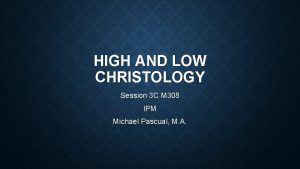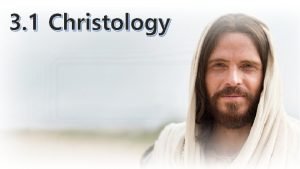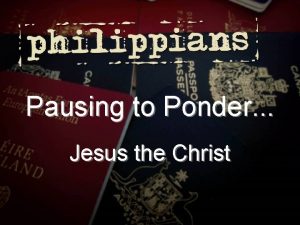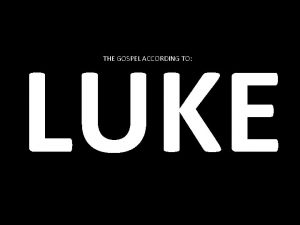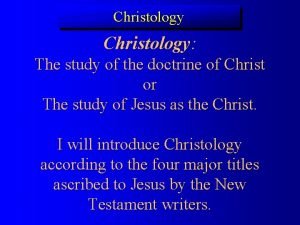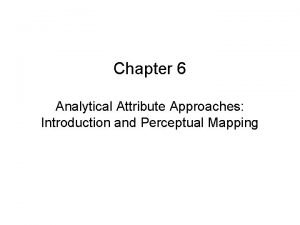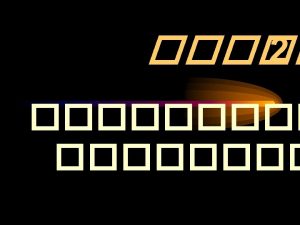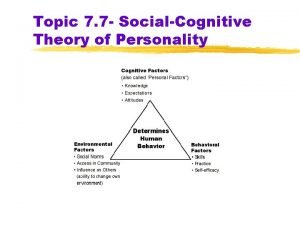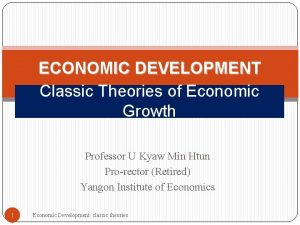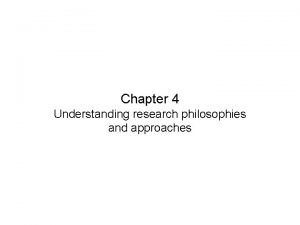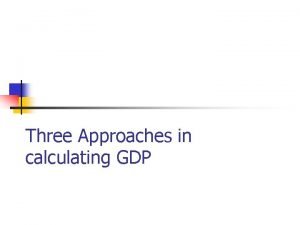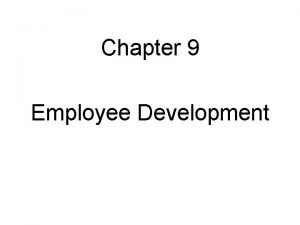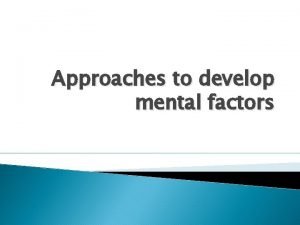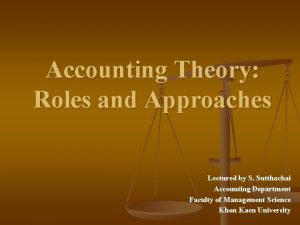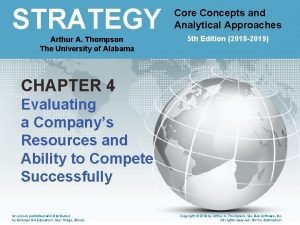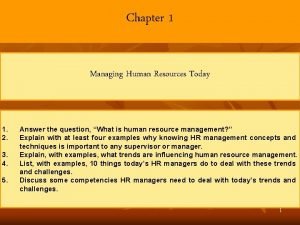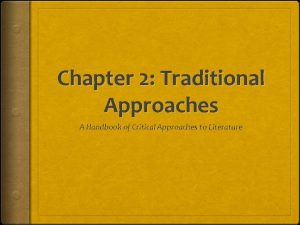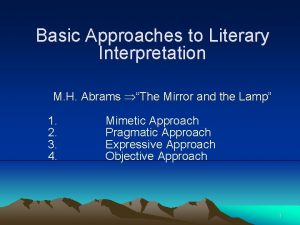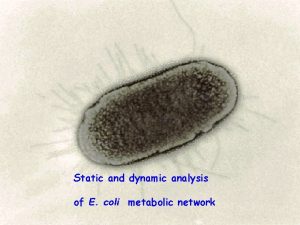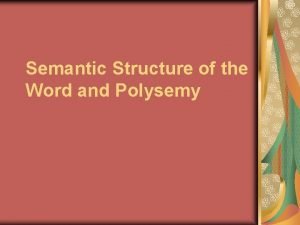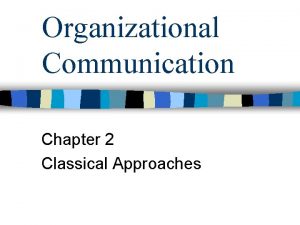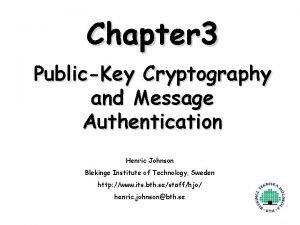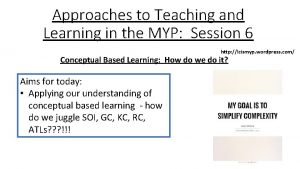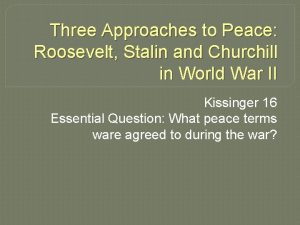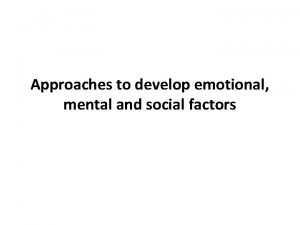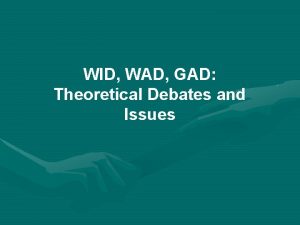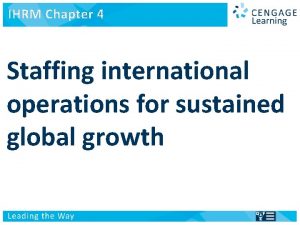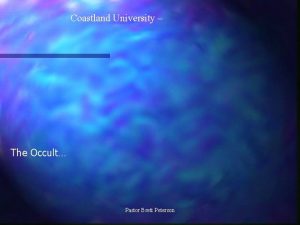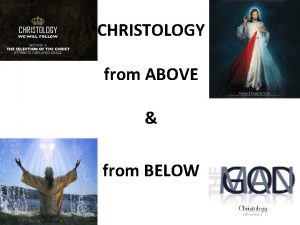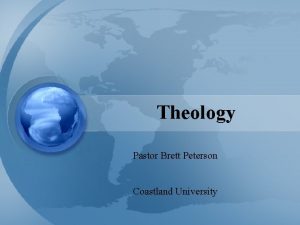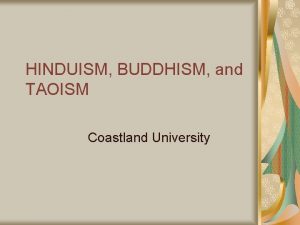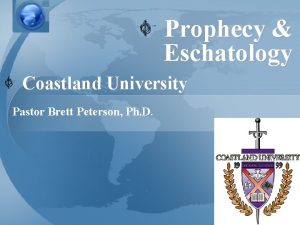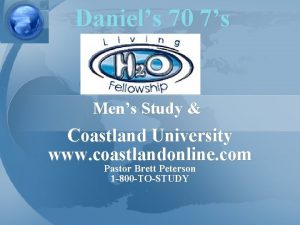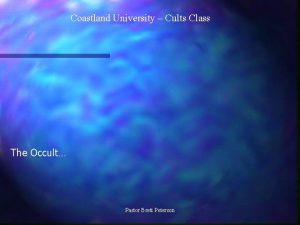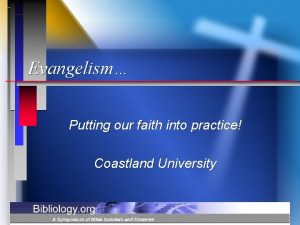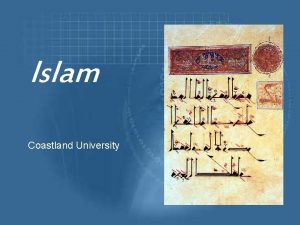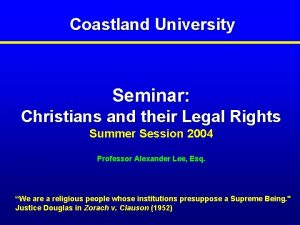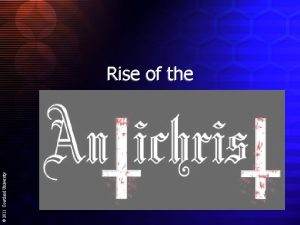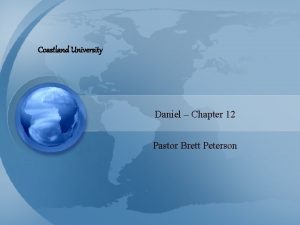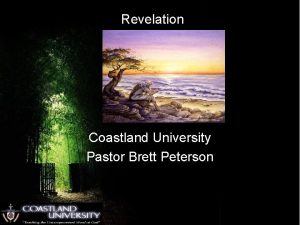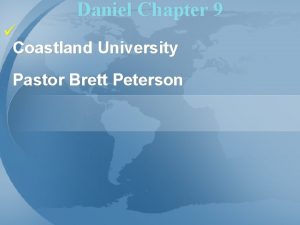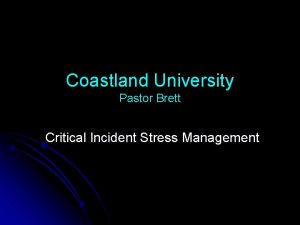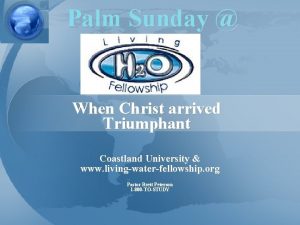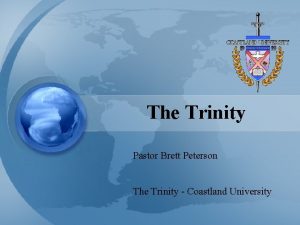CHRISTOLOGY Coastland University APPROACHES TO CHRISTOLOGY n Christology









































































- Slides: 73

CHRISTOLOGY Coastland University

APPROACHES TO CHRISTOLOGY n Christology from Above n n n Historic, Ecumenical and Creedal Approach Postulates that God, the Second Person, took unto himself true humanity Does not rule out Christology from below n Christology from Below n n n Favorite method of modern theologians Emphasizes humanity of Christ and his complete openness to God Does not rule out “from above” but infrequently goes there

ORTHODOX CHRISTOLOGY n Christ is God even as the Father is God n Christ is Human even as we are, excepting for sin n Christ is truly one person n God, the SON, took unto himself a true human nature and became the God-Man

Word Connotations – Sin n Old Testament Hebrew n Ht – missing the mark n Hattat – deviation from a norm n Pesha – breach of relationship, revolt against authority n Wh – twisting n Avon – guilt from deliberate wrongdoing n Segagah - straying n Resa - wickedness

Word Connotations – Sin n New Testament Greek n Hamartia – miss the mark n Paraptouma – error in measurement measure n Parabeasis – beyond the norm, outside the bounds n Asebai – ungodliness n Anomia – lawless n Adikea – unrighteousness, typically against a neighbor.

The Predicament of Sin n Who can restore creation from its brokenness? n What possibilities exist.

Luke 19: 10 n Jesus said to him, “Today salvation has come to this house, because this man, too, is a son of Abraham. 10 For the Son of Man came to seek and to save what was lost. ” • The New International Version, (Grand Rapids, MI: Zondervan Publishing House) 1984.

A Savior comes to Earth n Galatians 4: 4 “In the fullness of the time came, God sent forth His Son, born of a woman, born under the Law, 5 in order that He might redeem those who were under the Law, that we might receive the adoption as sons. • The New American Standard Bible, (La Habra, California: The Lockman Foundation) 1977. • Politically • Culturally • Religiously

The Purpose of His Coming “to give eternal life” John 3: 16 “For God so loved the world that he gave his one and only Son, that whoever believes in him shall not perish but have eternal life. ” n John 10: 28 “I give them eternal life, and they shall never perish; no one can snatch them out of my hand. ” n • The New International Version, (Grand Rapids, MI: Zondervan Publishing House) 1984.

The Purpose of His Coming “to give His life” n Mark 10: 45 “For even the Son of Man did not come to be served, but to serve, and to give his life as a ransom for many. ” • The New International Version, (Grand Rapids, MI: Zondervan Publishing House) 1984.

The Purpose of His coming “to reveal the Father” n n John 14: 9 “Anyone who has seen me has seen the Father. How can you say, ‘Show us the Father’? 10 Don’t you believe that I am in the Father, and that the Father is in me? The words I say to you are not just my own. Rather, it is the Father, living in me, who is doing his work. ” John 3: 34 “For the one whom God has sent speaks the words of God, for God gives the Spirit without limit. ” • The New International Version, (Grand Rapids, MI: Zondervan Publishing House) 1984.

The Purpose of His coming “to take our sin” n I Peter 2: 24 “He himself bore our sins in his body on the tree, so that we might die to sins and live for righteousness; by his wounds you have been healed. 25 For you were like sheep going astray, but now you have returned to the Shepherd and Overseer of your souls. ” • The New International Version, (Grand Rapids, MI: Zondervan Publishing House) 1984.

The Purpose of His coming “to be an example” n n I Peter 2: 21 “To this you were called, because Christ suffered for you, leaving you an example” John 13: 15 “I have set you an example that you should do as I have done for you. 16 I tell you the truth, no servant is greater than his master, nor is a messenger greater than the one who sent him. ” • The New International Version, (Grand Rapids, MI: Zondervan Publishing House) 1984.

The Purpose of His coming “to reconcile the world” n II Corinthians 5: 18, 19 “All this is from God, who reconciled us to himself through Christ and gave us the ministry of reconciliation: 19 that God was reconciling the world to himself in Christ, not counting men’s sins against them. And he has committed to us the message of reconciliation. ” • The New International Version, (Grand Rapids, MI: Zondervan Publishing House) 1984.

His birth – A Virgin birth n n Luke 1: 35 “The angel answered, “The Holy Spirit will come upon you, and the power of the Most High will overshadow you. So the holy one to be born will be called the Son of God. ” Isaiah 7: 14 “Therefore the Lord himself will give you a sign: The virgin will be with child and will give birth to a son, and will call him Immanuel. ” • The New International Version, (Grand Rapids, MI: Zondervan Publishing House) 1984.

His birth – An incarnation n n John 1: 1 -4 “In the beginning was the Word, and the Word was with God, and the Word was God. 2 He was with God in the beginning. 3 Through him all things were made; without him nothing was made that has been made. 4 In him was life, and that life was the light of men. ” Colossians 2: 9 “For in Christ all the fullness of the Deity lives in bodily form • The New International Version, (Grand Rapids, MI: Zondervan Publishing House) 1984.

His birth – Characterized by Humility n n n The Circumstances – Luke 2: 8 -14 2 Corinthians 8: 9 “For you know the grace of our Lord Jesus Christ, that though he was rich, yet for your sakes he became poor, so that you through his poverty might become rich. ” Hebrew 2: 14 “Since the children have flesh and blood, he too shared in their humanity so that by his death he might destroy him who holds the power of death —that is, the devil” • The New International Version, (Grand Rapids, MI: Zondervan Publishing House) 1984.

His Natures - Divine “to accomplish reconciliation” n n Colossians 2: 9 “For in Christ all the fullness of the Deity lives in bodily form” John 1: 1 -4 “In the beginning was the Word, and the Word was with God, and the Word was God. 2 He was with God in the beginning. 3 Through him all things were made; without him nothing was made that has been made. 4 In him was life, and that life was the light of men. • The New International Version, (Grand Rapids, MI: Zondervan Publishing House) 1984.

His Natures – Human “to enable Jesus to represent us” Luke 24: 39 “Look at my hands and my feet. It is I myself! Touch me and see; a ghost does not have flesh and bones, as you see I have. ” n Hebrews 2: 14 “Since the children have flesh and blood, he too shared in their humanity” n • The New International Version, (Grand Rapids, MI: Zondervan Publishing House) 1984.

Some of His Names n n n n Jesus – Yeshau – Yahweh is our salvation Savior – Matthew 1: 21 Messiah – “anointed one” Teacher - Mk. 4: 38; 9: 17, 38; 10: 17 Master - Lord Son of David Son of Man n Jesus most commonly used self referent.

Jesus office n Prophet – Luke 4: 18, 19 cf. Isaiah 62: 1, 2 n Priest – Hebrews 3: 1; 4: 14, John 1: 29 n King – Luke 1: 32, 32; Isaiah 9: 7; Ephesians 1: 22; Matthew 28: 18

Luke 4: 18, 19 quoting Isaiah 61: 1, 2 n “The Spirit of the Lord is on me, because he has anointed me n n n to preach good news to the poor. He has sent me to proclaim freedom for the prisoners and recovery of sight for the blind, to release the oppressed, to proclaim the year of the Lord’s favor. ” • The New International Version, (Grand Rapids, MI: Zondervan Publishing House) 1984.

“Doing the Father’s will” n John 4: 34 “My food, ” said Jesus, “is to do the will of him who sent me and to finish his work. ” • The New International Version, (Grand Rapids, MI: Zondervan Publishing House) 1984.

The Saving Work of Christ n Humiliation of Christ – His Experience n n Leaving heavenly Glory - Philippians 2: 6, 7 Suffering • • n n In His life – His own reject Him – John 1: 11 Forsaken by His disciples – Judas, Peter Condemned and sentenced by man Silently bears reproach. Death – the Cross – will to die – John 10: 17, 18 The grave

The Saving Work of Christ n His Death – Its meaning The curse of sin – Romans 6: 23 n Christ took the curse upon himself – John 1: 29, Mark 10: 45, Gal. 3: 13, I Peter 2: 24, Col 1: 19. n The Great High priest n • The Offerer - Galatians 4: 14 • The Offering – Hebrews 9: 28

The Saving Work of Christ n His Resurrection – its meaning The Seal of His work – Philippians 2: 8, 9 n Defeated death – Acts 2: 24, I Cor. 15: 20 n Defeated Satan – Ephesians 1: 22; 4: 8 n The First – I Corinthians 15: 20 n

The Saving Work of Christ Its significance for us n We are now at peace with God n Romans 5: 9 -11 “Since we have now been justified by his blood, how much more shall we be saved from God’s wrath through him! 10 For if, when we were God’s enemies, we were reconciled to him through the death of his Son, how much more, having been reconciled, shall we be saved through his life! 11 Not only is this so, but we also rejoice in God through our Lord Jesus Christ, through whom we have now received reconciliation. • The New International Version, (Grand Rapids, MI: Zondervan Publishing House) 1984.

The Saving Work of Christ Its significance for us n We are free from the curse of the Law Galatians 3: 13 “Christ redeemed us from the curse of the law by becoming a curse for us” n Romans 4: 25 “He was delivered over to death for our sins and was raised to life for our justification. n • (We are justified) • The New International Version, (Grand Rapids, MI: Zondervan Publishing House) 1984.

The Saving Work of Christ Its significance for us n Our view of life has changed n Colossians 3: 1 -2+ “Since, then, you have been raised with Christ, set your hearts on things above, where Christ is seated at the right hand of God. 2 Set your minds on things above, not on earthly things. ” • The New International Version, (Grand Rapids, MI: Zondervan Publishing House) 1984.

The Saving Work of Christ Its significance for us n The basis for our Hope n n 2 Cor. 4: 14 “because we know that the one who raised the Lord Jesus from the dead will also raise us with Jesus and present us with you in his presence. ” I Peter 1: 3 “In his great mercy he has given us new birth into a living hope through the resurrection of Jesus Christ from the dead, • The New International Version, (Grand Rapids, MI: Zondervan Publishing House) 1984.

The Ascended Lord John 14: 2 “I am going there to prepare a place for you. ” n John 17: 24 “Father, I want those you have given me to be with me where I am, and to see my glory, the glory you have given me because you loved me before the creation of the world. ” n • The New International Version, (Grand Rapids, MI: Zondervan Publishing House) 1984.

The Ascended Lord - His ongoing work n n n John 15: 26 “When the Counselor comes, whom I will send to you from the Father, the Spirit of truth who goes out from the Father, he will testify about me. ” Romans 8: 34 “Christ Jesus, who died— more than that, who was raised to life—is at the right hand of God and is also interceding for us” Ephesians 1: 22 “And God placed all things under his feet and appointed him to be head over everything for the church, 23 which is his body, the fullness of him who fills everything in every way. • The New International Version, (Grand Rapids, MI:

Revelation 1: 17, 18 n “Do not be afraid. I am the First and the Last. 18 I am the Living One; I was dead, and behold I am alive for ever and ever! And I hold the keys of death and Hades. ” • The New International Version, (Grand Rapids, MI: Zondervan Publishing House) 1984.

CHRIST IS GOD n Old Testament n n n n Psalm 2: 6 -12, “You are my son” Psalm 45: 6 -7, “Your throne, O God” Psalm 110: 1 ff, “The LORD says to my Lord” Isaiah 9: 6, “The Mighty God” Jeremiah 23: 6, “The LORD our Righteousness” Micah 5: 2, “from everlasting” Malachi 3: 1, “the Lord will come to his temple”

CHRIST IS GOD n New Testament: Matthew n n n n Matthew Father Matthew Matthew 9: 6, forgives sins 11: 7, complete knowledge of the 14: 33, receives worship 16: 16, “Son of God” 28: 18, “All authority” 28: 19, baptismal formula 7: 21, 10: 32 -3, 11: 25 -7, “My Father”

CHRIST IS GOD n New Testament: John 1: 1, “Word was God” n John 2: 24 “knew what was in man” n John 5: 18 “making himself equal with God” n John 11: 1 -14, Raising Lazarus from the dead n John 20: 28, “My Lord and My God” n I John 1: 3; 2: 23; 4: 14 -5; 5: 5, 10 -13, 20 n

CHRIST IS GOD n New Testament: Other Texts n n n n Romans 9: 5, “God, over all, blessed” Philippians 2: 6, “existed in the form of God” Colossians 2: 9, “in him all fullness dwells” Titus 2: 13, “the great God and our Savior” Hebrews 1: 3, “exact representation of his nature” Hebrews 1: 8, “Your throne, O God” Revelation 19: 16, “King of Kings, Lord of Lords”

CHRIST IS HUMAN Genesis 3: 15, Seed of the Woman n Genesis 49: 8 -10, Tribe of Judah n II Samuel 7, Psalm 89, Family of David n Isaiah 7: 14, born of a virgin n Isaiah 53, to suffer and die n

CHRIST IS HUMAN Matthew 1, Luke 2, Galatians 4: 4, born n Luke 2: 52, grew in wisdom and stature n Hebrews 2: 14, had flesh and blood n Luke 24: 39, had flesh and bone n Matthew 24: 36, ignorant of the day of judgment n

DEFINITION OF CHALCEDON - Hypostasis Inseparably Inconfusedly Unchangeably Indivisibly

Hypostatic Union n A theological term used with reference to the Incarnation to express the revealed truth that in Christ one person subsists in two natures, the Divine and the human. Hypostasis means, literally, that which lies beneath as basis or foundation. Hence it came to be used by the Greek philosophers to denote reality as distinguished from appearances (Aristotle, "Mund. ", IV, 21). It occurs also in St. Paul's Epistles (II Cor. , ix, 4; xi, 17; Heb. , i, 3: iii, 14), but not in the sense of person. Previous to the Council of Nicæa (325) hypostasis was synonymous with ousia, and even St. Augustine (De Trin. , V, 8) avers that he sees no difference between them. The distinction in fact was brought about gradually in the course of the controversies to which the Christological heresies gave rise, and was definitively established by the Council of Chalcedon (451), which declared that in Christ the two natures, each retaining its own properties, are united in one subsistence and one person (eis en prosopon kai mian hpostasin) (Denzinger, ed. Bannwart, 148). They are not joined in a moral or accidental union (Nestorius), nor commingled (Eutyches), and nevertheless they are substantially united.

KEY TERMS Father-Hypostasis, Persona Son. Hypostasis, Persona Human Divine Ousia, Nature One God Essence (Ousia) Holy Spirit. Hypostasis, Persona

HUMILIATION n He humbled himself, see Phil. 2: 7, 8: Kenosis “He laid aside the divine majesty, the majesty of the sovereign Ruler of the universe, and assumed human nature in the form of a servant. ” Berkhof, ST, 332.

HUMILIATION n n n Incarnation (Gal. 4: 4, Isa. 9: 6, Heb/ 2: 14, Phil. 2: 7) Made under the Law (Gal. 4; 4, John 6: 38, Heb. 5: 8, Phil. 2: 8) Sufferings and Death (Isa. 53) Wrath of God (II Cor. 5: 21, Isa. 53: 12, Ps. 40: 12, Matt. 27: 46) Death and Burial The descent into hell

EXALTATION n Resurrection: John 2: 19 -21; 10: 18, 11: 25; Acts 2: 24, n Ascension: Mark 16: 19; Luke 24: 50 -53; John 6: 62; n Session at the Right Hand of God: Matt. 26: 64; Acts n Judging the World at the Last Day: John 5: 22, 27; 32; 3: 26, 5: 30; Rom. 6: 4; I Cor. 15: 20; Col. 1: 18; Rev. 1: 5 14: 2, 12; 16: 5, 10, 17, 28; 17: 5; 20: 17; Acts 1: 6 -11; Eph. 1: 20; 4: 8 -10; I Tim. 3: 16; Heb. 1: 4; 4: 14; 9: 24 2: 33 -36; 5: 31; Eph. 1: 20 -22; Heb. 10: 12; I Peter 3: 22; Rev. 3: 21; 22: 1; Rom. 14: 9; I Cor. 15: 24 -28; Heb. 2: 7, 8; I John 2: 1 Acts 10: 42, 17: 31; Matt. 19: 28; 25: 31 -34; Luke 3: 17; Rom. 2: 16; 14: 9; I Cor. 3: 13 -15; II Cor. 5: 10; II Tim. 4: 1; James 5: 9

CHRISTOLOGICAL ERRORS NOT TRULY GOD NO HUMAN SPIRIT

CHRISTOLOGICAL ERRORS NO HUMAN SPIRIT TWO PERSONS

CHRISTOLOGICAL ERRORS TWO PERSONS ONE WILL

COUNCILS Nicea, A. D. 325, condemned Arianism as heresy (homoousios) n Constantinople, A. D. 381, condemned Apollinarianism as heresy n Ephesus, A. D. 431, condemned Nestorianism as heresy n Chalcedon, A. D. 451, condemned Eutychianism as heresy n

DEFINITION OF CHALCEDON We, then, following the holy Fathers, all with one consent, teach men to confess one and the same Son, our Lord Jesus Christ, the same perfect in Godhead and also perfect in manhood; truly God and truly man, or a reasonable soul and body; consubstantial with the Father according to the Godhead, and consubstantial with us according to the Manhood; in all things like unto us, without sin; begotten before all ages of the Father according to the Godhead, and in these latter days, for us and for our salvation, born of the Virgin Mary, the Mother of God, according to the Manhood; one and the same Christ, Son, Lord, Onlybegotten, to be acknowledged in two natures inconfusedly, unchangeably, indivisibly, inseparably; the distinction of natures being by no means taken away by the union, but rather the property of each nature being preserved, and concurring in one Person and one Subsistence not parted or divided into two persons, but one and the same Son, and only begotten, God the Word, the Lord Jesus Christ, as the prophets from the beginning have declared concerning him, and the Lord Jesus Christ himself has taught us, and the Creed of the holy Fathers handed down to us.

OFFICES OF CHRIST n WHAT ARE THE OFFICES OF CHRIST? n PROPHET, PRIEST, KING “Now it is to be noted that the title ‘Christ’ pertains to these three offices: for we know that under the law prophets as well as priests and kings were anointed with holy oil. ” Calvin, ICR, II, 15, 2

OFFICES OF CHRIST: PROPHET n The biblical idea of prophet is one who speaks on behalf of God: Ex. 4: 15, 16; 7: 1, cf. Jer. 1: 5, 9. Evangelical Dictionary of Biblical Theology, s. v. “Prophet. ” n n This involves forth-telling most definitely (2/3 of OT prophetic activity, per Walter Kaiser in above noted article) May involve fore-telling (1/3 of OT prophetic activity) ATTRIBUTED TO RUTILIO MANETTI Christ Disputing with the Elders, c. 1628 -29 BJU Art Gallery

OFFICES OF CHRIST: PROPHET n n The Messiah would be a prophet, Deut. 18: 18, 19; cf. Acts 3: 22 f Jesus was recognized as prophet, John 4: 19, 25, 26; cf. John 1: 21 As prophet, he definitively declares to us the will of God, Heb. 1: 1. See L. C. #43 Other important Scriptures: Isaiah 9: 6; 11: 2 -4; 61: 1 -3 (Luke 4: 21); John 1: 18; 3: 34; I Peter 1: 10, 11.

OFFICES OF CHRIST: PRIEST n n As priest, he experiences our circumstances and redeems us from sin, offering himself a sacrifice for sins (Jesus is both sacrificer and sacrifice), Heb. 9: 25, 28; 10: 5 -14. See L. C. # 44 Other important Scriptures: Heb. 4: 15 -6; 5: 8; 7: 25; I John 2: 1

OFFICES OF CHRIST: PRIEST n n n Biblical idea of priest- one who intercedes to God on behalf of man: Hebrews 5: 1 -4; Deut. 18: 5; Ex. 29: 20; Joel 2: 17; Lev. 10: 9 -11; Micah 3: 11; Deut. 17: 9 -13 Melchizedek was a type of Christ: Gen 14: 18 -20; Psalm 110: 4; Heb. 7 Messiah would be a priest: Psalm 10: 4; 24: 7 -10; Heb. 5: 5, 6; Isa. 40: 10, 11; Zech. 6: 9 -15

OFFICES OF CHRIST: KING Judging as King, Sistine Chapel n n The biblical idea of king is one who reigns and exercises sovereign dominion: Gen 3: 15; 17: 5; 22: 16, 17; 49: 9, 10; . 15: 5, 6; 19: 5, 6; I Peter 2: 9; Rev. 1: 5. Messiah would be a King, Gen. 49: 9, 10; Psalm 89; Isa. 9: 7

OFFICES OF CHRIST: KING As King, he rules over us and over our enemies till are brought into submission, I Cor. 15: 24 -28. See L. C. #45 n Other important Scriptures: Matt. 28: 18, “all authority is given to me in heaven and on earth. ” Also, Acts 5: 31; Rom. 8: 28 n

THE ATONEMENT: VIEWS n Classical Theory n n Associated with Gustav Aulen, Christus Victor Christ’s atonement is a victory over the hostile forces arrayed against him • These are the “tyrants” which would bind man in sin • Christ breaks the power of evil that enslaves mankind • Aulen refers to Rom. 4: 4, 7: 9, 10: 4; Gal. 3: 13; Col. 2: 14 as key texts for this formulation • Irenaeus (A. D. 175? ) speaks of “Recapitulation” and Athanasius (A. D. 296 -373) calls Christ “our representative” • Theory is not problematic in what it asserts. It is not, however, a complete explanation of redemption.

THE ATONEMENT: VIEWS n Ransom to Satan Theory originated by Justin Martyr (A. D. 100165) • Focused on the conquest of the devil in the work of redemption, ransom • Elaborated further by Origen (A. D. 185 -254), who also propounded the deification of man • Based on the fact that Christ’s death is a ransom, and that he delivered us from Satan • Theory assumes that Satan has some power or judicial standing that is not consistent with the biblical description of his role and authority • “Buying back” is central to the biblical notion of redemption.

THE ATONEMENT: VIEWS n Commercial (Satisfaction) Theory n Theory originated by Anselm (A. D. 1033 -1109) in an attempt to respond to Origen’s view • Introduced the word satisfactio into theological discussion • The theory is worked out in Anselm’s book, Cur Deus Homo • According to Anselm, operating out of his feudal culture, we owe God either obedience or death • Christ was obedient, but he also died; thus, he paid twice • He is, therefore, able to apply credit to our standing • This theory tends to neglect the teaching that Christ’s active obedience is imputed to us also

THE ATONEMENT: VIEWS n Example Theory (Martyr Theory) n Theory proposed by Peter Abelard (A. D. 1079 -1142) • “It is evident that all this was done in order that he might show great love he had for men, and so inflame them to greater love in return. ” Epitome, 25 • View commonly held by Socinians and Unitarians • Subjective sinfulness the only barrier between God and man • God does not need to be reconciled; instead, man is in need of reconciliation • Theory keys on the idea that God initiates reconciliation • Death of Christ influences us to turn from our sins • Problem: this theory takes an element of truth and expands it to the whole truth. That man needs reconciliation is truebut not as important as fact that God needs to be reconciled

THE ATONEMENT: VIEWS n Governmental Theory n Theory was introduced by Hugo Grotius, a Dutch lawyer, A. D. 1583 -1645 • Theory keyed on Isaiah 42: 21 which speaks of God’s law • To forgive sinners without anything being done would negatively affect God’s government • Therefore, God punished Christ to show he is serious about sin • Christ is used as an example and the cross does not constitute a full payment of sin. Instead, a relaxation of the penalty occurs • The theory holds to idea of substitution, but not equitable substitution; it leads to questions about God’s justice

THE ATONEMENT: VIEWS n Moral Influence Theory n Proponents of this theory: Horace Bushnell (A. D. 1802 -1876), F. D. E. Schleiermacher (A. D. 17681834), and Albrecht Ritschl (A. D. 1822 -1889) • • No principle in the divine nature propitiated by Christ’s work Instead, the death of Christ displays God’s love for man This shames men to turn from sin and repent The purpose of the atonement was not to satisfy divine justice, but to reveal divine love • Christ is not only an exemplar, but a power of righteousness who has entered into human life and revealed God to us • The problem with this theory is that it takes an element of truth and expands it to become the whole truth

THE ATONEMENT n Vicarious, Substitutionary Atonement: Satisfaction n Christ was the Second Adam • He fulfilled the Covenant, Active Obedience (Rom 5: 19)- positively keeping the law • He atoned for Covenant-breaking, Passive Obedience (II Cor. 5: 20, 21)- vicariously suffering the penalty of law-breaking

THE ATONEMENT “We must avoid the mistake of thinking that the active applies to the obedience of his life and the passive to the obedience of his final sufferings and death. The real use and purpose of the formula is to emphasize the two distinct aspects of our Lord’s vicarious obedience. The truth expressed rests upon the recognition that the law of God has both penal sanctions and positive demands. It demands not only the full discharge of its precepts but also the infliction of penalty for all infractions and shortcomings. It is this twofold demand of the law of God which is taken into account when we speak of the active and passive obedience of Christ as the vicar of his people came under the curse and condemnation due to sin and he also fulfilled the law of God in all its positive requirements. In other words, he took care of the guilt of sin and perfectly fulfilled the demands of righteousness. He perfectly met both the penal and the preceptive requirements of God’s law. ” Murray, Redemption Accomplished and Applied, 22 -23

ATONEMENT n New Testament Language n REDEMPTION · lutron, (ransom)……Matt. 20: 28, Mark 10: 45; I Tim. 2: 6; Heb. 9: 15 · lutrosin, (redemption). …. Luke 2: 38; Rom. 3: 24; 8: 23; I Cor. 1: 30; Eph. 1: 7; 14; 4: 30 · lutrwthn, (redeemer)……Acts 7: 35 · lutrousqai, ……Luke 24: 21 (buy back from the slave market of sin); Gal. 4: 5; Titus 2: 14 n SACRIFICE · qusias, ……Heb. 9: 26

ATONEMENT n New Testament Language n PROPITIATION • ‘ilasmos, ……I John 2: 2 • ‘ilasqhti, …. Luke 18: 13; Heb. 2: 17 (be propitious, make propitiation) • ‘ilasthrion, ……Romans 3: 25 (atoning sacrifice) n RECONCILIATION · katallassw, … Rom 5: 10; I Cor. 7: 11, II Cor. 5: 18 -20 (reconcile) · katallagh, ……………. Rom. 5: 11; 11: 15; II Cor. 5: 19. He humbled himself, see Phil. 2: 7, 8: Kenosis “He laid aside the divine majesty, the majesty of the sovereign Ruler of the universe, and assumed human nature in the form of a servant. ” Berkhof, ST, 332.

PENAL SUBSTITUTION n n n n The sufferings of Christ were not a substitute for the penalty of the law, but they are the penalty inflicted upon the substitute It was not a pecuniary quid pro quo, but it was strictly a penal substitution It was not [simply] an example of punishment It was not [simply] an exhibition of love or other sentiment The guilt, or legal responsibility (not the depravity or corruption) of our sin was imputed to him He suffered precisely the suffering that divine justice demanded he suffer in our stead His sufferings were those of a divine person in a human nature (A. A. Hodge, The Atonement)

Emptying n Mar 1: 12 Immediately the Spirit impelled Him {to} {go} out into the wilderness.

n Hbr 4: 15 For we do not have a high priest who cannot sympathize with our weaknesses, but One who has been tempted in all things as {we are, yet} without sin.

n Mat 26: 39 And He went a little beyond {them, } and fell on His face and prayed, saying, "My Father, if it is possible, let this cup pass from Me; yet not as I will, but as You will. "

n Mat 24: 36"But of that day and hour no one knows, not even the angels of heaven, nor the Son, but the Father alone.

n Jhn 11: 35 Jesus wept.
 Low christology examples
Low christology examples What is christology?
What is christology? Christology in telugu
Christology in telugu Christology definition
Christology definition Ascending christology meaning
Ascending christology meaning Low christology
Low christology Christological
Christological 詹景裕
詹景裕 Approaches to child development
Approaches to child development Analytical attribute techniques
Analytical attribute techniques Pricing considerations and approaches
Pricing considerations and approaches Classical approaches to management
Classical approaches to management Cognitive perspective of personality
Cognitive perspective of personality Organizational communication: approaches and processes
Organizational communication: approaches and processes Hollis chenery
Hollis chenery Research philosophies and approaches
Research philosophies and approaches Result approach in measuring performance
Result approach in measuring performance A framework for thinking ethically
A framework for thinking ethically Approaches meets masters
Approaches meets masters Literary approaches
Literary approaches Value added approach formula
Value added approach formula Theory x and theory y
Theory x and theory y Four approaches to employee development
Four approaches to employee development Structuralist or formalist
Structuralist or formalist Literary approaches examples
Literary approaches examples Disadvantages of mental rehearsal in sport
Disadvantages of mental rehearsal in sport Steps in policy making
Steps in policy making Ap psychology module 2 review
Ap psychology module 2 review Accounting theory definition
Accounting theory definition Approaches of health promotion
Approaches of health promotion Experimental research design types
Experimental research design types Strategy core concepts and analytical approaches
Strategy core concepts and analytical approaches What are the five basic functions of the management process
What are the five basic functions of the management process Historical biographical approach to his coy mistress
Historical biographical approach to his coy mistress Basic approaches to literary interpretation
Basic approaches to literary interpretation Data cleaning problems and current approaches
Data cleaning problems and current approaches Theories about group living
Theories about group living Power bi governance and deployment approaches
Power bi governance and deployment approaches Integrative approach in language testing
Integrative approach in language testing Graphic organizer activity 1 approaches to psychology
Graphic organizer activity 1 approaches to psychology Approaches to systems development
Approaches to systems development Computational approaches
Computational approaches Literary criticism
Literary criticism How did wilhelm wundt break down consciousness
How did wilhelm wundt break down consciousness Approaches to environmental ethics
Approaches to environmental ethics Simplified directional facility
Simplified directional facility The 7 approaches to psychology
The 7 approaches to psychology Semantic structure of the word
Semantic structure of the word Modern theories of organizational communication
Modern theories of organizational communication Pricing approaches
Pricing approaches 7 approaches to psychology
7 approaches to psychology Personal selling skills
Personal selling skills Physical spatial approach in tourism planning
Physical spatial approach in tourism planning Working capital management
Working capital management Approaches to message authentication
Approaches to message authentication Approaches to learning myp
Approaches to learning myp Three approaches to peace
Three approaches to peace New approaches to sme financing
New approaches to sme financing What are the different literary approaches
What are the different literary approaches 7 brand approaches
7 brand approaches Directive approaches for responding to defensive behaviors
Directive approaches for responding to defensive behaviors Social demand approach
Social demand approach Logging instrument approaches
Logging instrument approaches Public health approaches
Public health approaches Three approaches to decision making
Three approaches to decision making Lim as x approaches infinity
Lim as x approaches infinity Approach in literary criticism
Approach in literary criticism Approaches to develop social factors
Approaches to develop social factors Trait theories
Trait theories Mental sub factors national 5 pe
Mental sub factors national 5 pe Psychology perspectives
Psychology perspectives What is wad approach
What is wad approach Ihrm objectives
Ihrm objectives Social cognitive approaches to personality
Social cognitive approaches to personality
